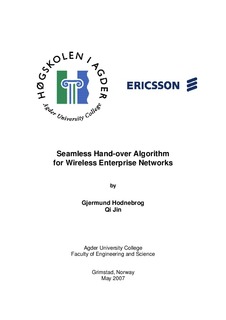| dc.contributor.author | Hodnebrog, Gjermund | |
| dc.contributor.author | Jin, Qi | |
| dc.date.accessioned | 2009-03-12T11:28:45Z | |
| dc.date.issued | 2007 | |
| dc.identifier.uri | http://hdl.handle.net/11250/137092 | |
| dc.description | Masteroppgave i informasjons- og kommunikasjonsteknologi 2007 – Høgskolen i Agder, Grimstad | en |
| dc.description.abstract | The mass deployment of the Institute of Electrical and Electronics Engineers’ (IEEE) 802.11
based wireless local area networks (WLAN) and increased sales in hand-held devices
supporting WLAN have resulted in an urgent need to support fast WLAN handovers or
roaming. The reason for this problem arising now is that hand-held devices are more mobile
than a laptop and their users actively use their hand-held equipment while moving. Laptop
users are often called nomadic users in contrast to the real mobile users.
The customarily solution is that when a connection is lost with the associated access point,
one tries to find a new access point and tries to connect to it. The process of finding a new
access point and connecting to it takes too long time in current implementations. Some
applications cannot tolerate to be interrupted or disconnected for a very long time period
before the session breaks. Therefore we need mechanisms to make sure that the disconnection
time is as low as possible.
Our algorithm uses an improved threshold scheme to detect the handover. The algorithm
avoids many unnecessary handovers and prevents rapidly dropped signal strength or poor
connection quality. In addition, we do scanning and AP selection before critical situations
occur and therefore are faster in disconnecting from the current AP. As a result, the whole
disconnection time is only the handover execution time, which is much shorter than the
customarily one’s. Furthermore, we use signal strength, hysteresis and trends to classify the
candidate APs. The result allows us to choose the best one of them and then switch to it.
Through thresholds and hysteresis based decisions we avoid the latent unnecessary handovers
resulting in a undesired “yoyo” effect, where the client continuously jumps back and forth
between APs.
Our handover algorithm is signal strength based. For technical reasons, the signal strength is
the main parameter we considered. In the future, several other quality parameters can be
implemented into our algorithm to make the algorithm even more efficient, e.g., by querying
APs about their current load and QoS resources. | en |
| dc.format.extent | 2177915 bytes | |
| dc.format.mimetype | application/pdf | |
| dc.language.iso | eng | en |
| dc.publisher | Høgskolen i Agder / Agder University College | en |
| dc.subject.classification | IKT590 | |
| dc.title | Seamless Hand-over Algorithm for Wireless Enterprise Networks | en |
| dc.type | Master thesis | en |
| dc.subject.nsi | VDP::Technology: 500::Information and communication technology: 550::Telecommunication: 552 | en |
| dc.source.pagenumber | 72 | en |
